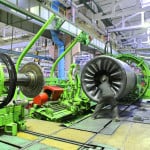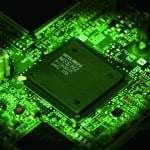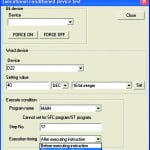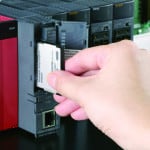Condition Monitoring
With manufacturing and process businesses across the globe facing ongoing increasing pressures to boost production performance and reduce costs, Thomas Lantermann, Senior Business Development Manager at Mitsubishi Electric Europe B.V., Factory Automation – European Business Group and Douglas Wilson of Raima look at the importance of condition monitoring, outlining what is possible today and highlighting what is still to come.
As companies look to reduce costs, increase productivity and raise their OEE (overall equipment effectiveness) scores to world class levels in the face of increasingly global competition, key considerations include optimizing asset utilization, reducing waste, lowering energy consumption and maximizing uptime.
Energy consumption and the cost of unscheduled downtime are of particular concern. Legislation in place across Europe makes it essential for companies to manage energy consumption and minimize energy spikes, while the cost of unscheduled downtime for repairs can run into tens of thousands of pounds every hour. The ability to predict problems and address them pre-emptively during periods of scheduled maintenance is vital.
One of the primary tools to address these issues is condition monitoring. Here, key parameters that indicate the condition and operation of plant and machinery are continuously monitored, for example looking for significant changes that could indicate a developing fault. Typical parameters to monitor include the likes of vibration, temperature, lubricant contamination, noise and current draw.
There was a time when condition monitoring was conducted only periodically, and meant teams of Doctorate-qualified scientists poring over charts and graphs, analyzing spikes that could be indicative of machinery drifting out of balance. It was an expensive process, and only justifiable on the most costly assets or highest value production lines. But the picture has changed radically in recent years, with numerous off the shelf sensors providing simple indication that equipment is drifting out of tolerance.
Expanding applications
Such condition monitoring is vital on high value assets such as wind turbines, but emerging condition monitoring techniques and technologies mean that it can also provide cost-effective protection for smaller machines, enabling anyone to improve efficiencies, reduce energy consumption and eliminate downtime. Individual monitoring channels can be dedicated to any and every pump, fan, motor, centrifuge, turbine or vibrating screen, providing effective and affordable condition monitoring.
The latest smart devices, combined with improvements in connectivity, fieldbus and Ethernet-based networks across all industry sectors have been key drivers behind the growing adoption of condition monitoring techniques. But an important consideration is how to collect, store, manage, analyze and act upon the vast amounts of data that are generated by numerous condition monitoring devices.
The resulting data streams certainly cannot be monitored manually, but increasingly they are also beyond traditional plant automation architectures. While PLCs (programmable logic controllers) are ideal for sequential control and some analogue processing, they don’t have the data crunching or analysis power to derive usable conclusions from large streams of condition monitoring data.
At the same time, getting these vast data streams from the plant floor to higher level databases is often problematic: traditional PC (personal computer) database solutions can be difficult, costly and time consuming to integrate with plant floor control systems, and limit the speed and volume of data transfer. In addition, once the data has been analyzed, relaying actionable information back to the automation system can be difficult to optimize.
What is needed is a new approach, and it has to start within the automation architecture. Mitsubishi Electric has addressed this with its C Controller – a dedicated C-language CPU that operates standalone or mounts on standard MELSEC Q series PLC hardware. Integrating seamlessly with proven Q series I/O, networking modules and motion control cards, the C Controller CPU provides a flexible, reliable, readily expandable, rack-based PC solution as part of a multi-disciplinary automation platform.
The sort of data analysis required by condition monitoring is inherently better suited to a PC-based approach than a PLC-based approach, and many systems developers are far more comfortable developing complex data analysis programs in C or C++ than in PLC languages.
Both ways
The C Controller provides the best of both worlds, opening up the world of automation to engineers who program in C and C++, with standard MELSEC Q series hardware that assures high system reliability, stable long-term supply and lower maintenance and management costs. It delivers advanced PC-based control with reduced total cost of ownership and increased stability of operation, with the added advantage of seamless integration with the PLC and wider automation environment.
The C Controller is available in three Mitsubishi Electric iQ Platform ready CPU (central processor unit) modules. The Q12DCCPU and Q24DCCPU models include two and three Ethernet ports respectively, a RS232 port, an USB port, a CompactFlash card slot and a 7-segment display for debugging and diagnostics. The third model called Q06CCPU provides an Ethernet port, RS232 port and a CompactFlash card slot. All CPUs come with the Wind River VXWorks real time operating system pre-installed. Program development environment options include Mitsubishi Electric’s own CW Workbench and Wind River’s Work Bench for the Q12 and Q24DCCPU, or Tornado for the Q06CCPU.
CW Workbench is a new engineering tool from Mitsubishi Electric designed specifically for the C Controller, enabling full scale embedded systems to be developed quickly, easily and at low cost. CW Workbench offers all the essential functionality required for system development, including an editor, compiler and debugger. Mitsubishi Electric also offers a full suite of setting and monitoring tools for the C Controller CPUs, providing program-free parameter settings and program-free diagnostics. This leads to a simple means for monitoring the status of connected modules and easily performing simple debugging.
Taking the solution a step further with regard to collecting, storing, managing and analyzing the huge volumes of data associated with condition monitoring, Mitsubishi Electric has worked with e-F@ctory Alliance partner Raima to enable Raima’s RDM Embedded database technology to run on the C Controller CPU.
This provides a rugged database platform that allows data to be stored, managed and accessed directly with the controller rather than using a higher level PC database, offering huge potential for increased performance and easier integration. It allows users to take advantage of both the real time operating system, along with the C programming environment of the CPU, to customize RDM Embedded to specific application requirements.
Database technology
RDM Embedded is a high performance, small footprint embedded database solution successfully deployed in millions of business-critical applications and devices over the last 25 years. Embedded within the Mitsubishi Electric C Controller, the combined Mitsubishi Electric-Raima C NetDB solution delivers a database that can collect controller data in a fast, predictable and reliable manner, with live real-time response to keep up with fast changing events and frequently updating data. It is an ACID (Atomicity, Consistency, Isolation, Durability) compliant database, meaning that the information collected is guaranteed to be accurate. Automatic recovery features ensure that data will never be corrupted due to a system failure. And RDM Embedded provides the high availability needed in modern manufacturing processes.
Easy to set up, the C NetDB is delivered with the operating system pre-installed, and just needs to be inserted into the Mitsubishi Electric Q Platform base rack. It can then easily be configured and customized to individual needs using standard C programming. Compared to a traditional PC solution, maintenance time and costs are reduced significantly. For example: the stable operating environment does not need the constant patching and upgrades seen with a traditional PC OS (operating system). In addition, this reduces the troublesome compatibility issues sometimes encountered when PC OSs change.
Key features include the ability to conduct a single query across multiple targets, with circular tables that can be queried by SQL (Structured Query Language). In addition, RDM embedded provides features such as database cursors, shared memory protocol, multiple data types, bulk insert API (application programming interface), ‘dirty read’ isolation level, enhanced encryption, and selective replication and notification.
Along with standard data types such as integer, character, wide characters, and binary, RDM also supports data types such as date/time/timestamp, BCD (binary-coded decimal) and GUID (globally unique identifier). Date/time/timestamp allows natural time-based logging and manipulation. BCD is a standard database representation for meeting the needs of applications where exact values are required in all decimal digits. The GUID data type provides unique 128-bit algorithm-generated identifiers, with a far better guarantee of uniqueness than can be achieved using sequence generators.
The optional web-based interface, through its micro HTTP (hypertext transfer protocol) server as well as a powerful replication server, gives enhanced flexibility. For example, the replication feature allows data to be moved from Raima’s RDM Embedded database to third party data stores (such as SCADA (supervisory control and data acquisition) systems, ERP (enterprise resource planning) systems and enterprise databases). Such features make remote access to the database simpler yet extremely powerful, allowing for more complex deployment of monitoring and control industrial applications.
RDM’s replication functionality includes third party replication and support for multiple master to single slave selective replication of circular table data—important for devices at the edge of the network where condition monitoring occurs. The data stored in each master’s circular table is replicated to a central control system which maintains a permanent history of all device data which can then be made available for a variety of time series and other analyses.
High performance
RDM Embedded is a high performance data management solution offering the live real-time response that is needed in modern condition monitoring applications, with potentially vast streams of live event data. The highly optimized database engine supports extremely high transaction rates, and supports all mainstream real time operating systems.
In addition to real-time processing, RDM Embedded further improves response speeds with an ACID compliant database engine that supports multiple indexing methods, including B-tree and hash indexes, according to application and performance requirements. Hashing on large volumes often provides faster access to data than B-tree indexing methods.
As an example, vibration monitoring can highlight developing faults in rotating machinery. Using accelerometers, readings can be taken on machine bearing casings to measure vibration, while other sensors can measure rotating shafts to measure their radial and axial displacement. Comparing the vibration levels to historical baseline values can indicate impending bearing failure, and enable action to be taken.
Variable speed drives now provide diagnostics such as warnings on current draw values that can indicate deterioration in motor performance, or which might highlight problems in the equipment connected to the motor shaft.
At the same time, the latest generations of energy monitors can provide output of the energy consumption of everything from a single key component to a full machine. Temperature sensors and fixed-in-place thermal imaging cameras can provide useful indicators of both energy consumption and impending component failure. In industries where effective lubrication is critical, the latest generations of conductivity sensors can reliably detect levels of water in oil, long before high water levels begin to cause problems.
We can see, then, that RDM Embedded running on the Mitsubishi Electric C Controller addresses the need for secure, real-time throughput of condition monitoring data that today’s manufacturing enterprises require. Robust and automated data management, flow and analysis delivers numerous advantages. Early detection of developing faults means fewer breakdowns, and results in increased uptime which in turn means increased productivity.
The ability to spot machines and equipment drifting out of tolerance means product quality is always high, and waste production is reduced. Improved maintenance scheduling reduces costs, as does the ability to monitor and manage energy consumption. Superior asset utilization reduces the need for capital expenditure on additional machines, whilst the ability to detect faults before critical failure means there is reduced need to hold expensive stocks of spare parts.
Future
And there is more to come, as condition monitoring technologies and analysis strategies become ever more sophisticated. Already we are seeing the emergence of analysis packages that can infer parameters in difficult to monitor applications. For example, looking at two parameters that can be monitored, it is then possible to infer the value of a third parameter, and take maintenance or production decisions based on that inference. Further, we can expect mathematical models to improve, and associated software to become more adept at refining both condition monitoring data and event data, enabling better and more informed decisions to be taken.
As sensors and monitoring devices become ever smarter, the quality and amount of data available will increase, with whole new levels of data about status, production efficiency, energy consumption, machine availability and more. In tandem, the rise of Machine-to-Machine (M2M) communications is driving a new model of connected intelligence, marrying efficient communications with cost-effective data transfer costs. M2M communications makes data the ultimate management tool, enabling users to implement and operate vastly more sophisticated and complex systems whilst still being able to monitor effectively what is happening within those systems.
Mitsubishi Electric Europe and e-F@ctory Alliance partner Raima are at the forefront of this revolution in condition monitoring, with a partnership that is both strong and enduring. The decades of experience of these two market leaders, across all sectors of industry, means they are not simply reacting to user demand, but are actually driving developments in areas such as condition monitoring, giving end users the tools they need to boost performance and reduce costs.
About Raima
Raima delivers high-performance, always on database technology for both in-memory database usage and persistent storage devices. Raima’s core focus is to develop database management solutions for everything from small, embedded devices up to enterprise level hardware systems.
The Raima Database Manager (RDM) products are cross-platform, small footprint, fast and reliable database solutions which are made to collect, store, manage and move data. They are used worldwide in a wide range of data management solutions in industries such as industrial automation systems, military flight control systems, telecom routers & switches, financial trading systems, medical equipment, data backup solutions, consumer electronic devices and more.
All products feature solid and reliable ACID compliant database technology and employ a number of advanced solutions to meet today’s complex data management challenges. Examples are moving data from small low-powered embedded devices up into larger enterprise systems, building highly-available database systems, database partitioning support to facilitate data distribution and scalability, and interfaces allowing access to the data from a range of external sources.
Raima Database Manager (RDM) products include options to meet a variety of data management architectural designs by providing a choice of data models and access methods to solve the most stringent performance requirements.
For more information on RDM or to download the SDK for evaluation visit the product page.































